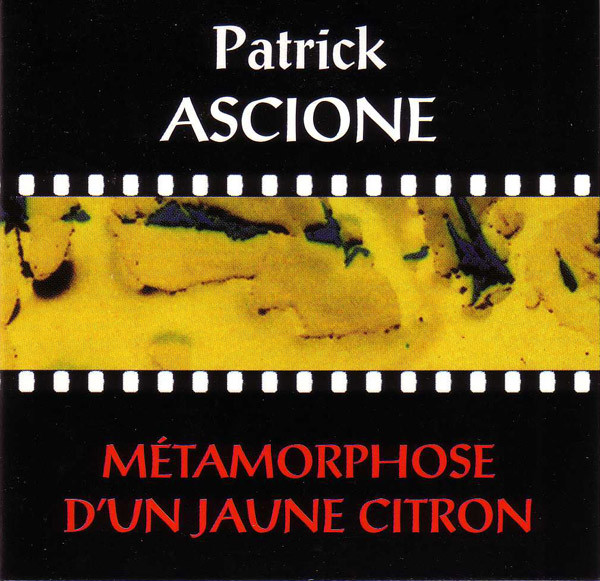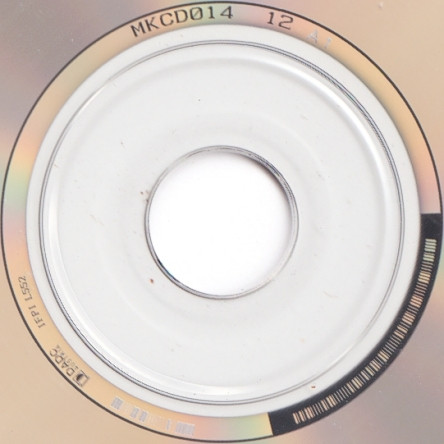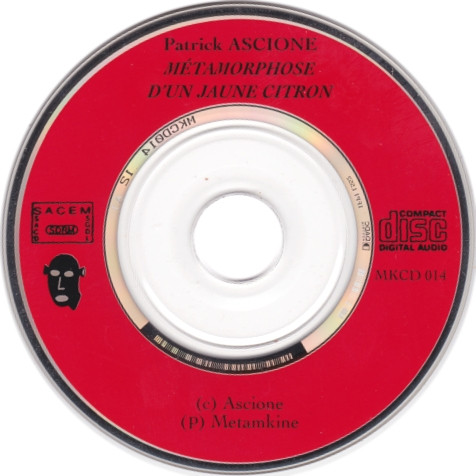MusiQ
Patrick Ascione - Métamorphose DUn Jaune Citron
Table of Contents
Download
Filename: patrick-ascione-mtamorphose-dun-jaune-citron.rar- MP3 size: 7.7 mb
- FLAC size: 40.9 mb
Tracks
| Track | Duration | Preview |
|---|---|---|
| Métamorphose D'Un Jaune Citron | 14:02 |
Images






Catalog Numbers
MKCD014, MKCD 014Labels
MetamkineListen online
- ascolta in linea
- kuunnella verkossa
- écouter en ligne
- lyssna på nätet
- online anhören
- ouvir online
- lytte på nettet
- escuchar en línea
- online luisteren
Formats
- CD
- Mini
Companies
| Role | Company |
|---|---|
| Copyright (c) | Patrick Ascione |
| Phonographic Copyright (p) | Metamkine |
| Produced At | GMEB |
| Glass Mastered At | DADC Austria |
Credits
| Role | Credit |
|---|---|
| Composed By | Patrick Ascione |
| Cover | Christophe Auger |
| Curated By | Jérôme Noetinger |
Notes
- Musique concrète réalisé en [realized in] 1979.
- Dans le studio l'auteur et aux studios du GMEB.
- [In the author's studio and at the GMEB studios.]
- Création publique le 1er juin 1979 Palais Jacques Cœur á Bourges.
- [Public creation on 1 June 1979 at Palais Jacques Cœur in Bourges.]
- Remerciements: Corinne Denouail, Richard et Lucienne, Jean Rougé, GMEB.
- [Thanks: Corinne Denouail, Richard and Lucienne, Jean Rougé, GMEB.]
- Gatefold cardboard sleeve.
- Catalogue numbers are: MKCD014 (on cover) and MKCD 014 (on CD).
- (c) Ascione
- (P) Metamkine
- Musique concrète réalisée en 1979 dans le studio de l'auteur et aux studios du GMEB.
- Création publique le 1er juin 1979, Palais Jacques Cœur à Bourges.
- Remerciements: Corinne Denouail, Richard and Lucienne, Jean Rougé, GMEB.
- Metamkine address on rear cover: 13 rue de la Drague, 38600 Fontaine, France.
Barcodes
- Rights Society: SACEM SDRM SACD SGDL
- Matrix / Runout: [DADC AUSTRIA logo] MKCD014 12 A1
- Mastering SID Code: IFPI L552
- Matrix / Runout: [DADC Austria logo] MKCD014 12 A1
About Patrick Ascione
Patrick Ascione (Paris, France, October 22nd 1953, November 21st 2014) began composing in 1976 and shortly after joined the team of the Groupe de musique expérimentale de Bourges (GMEB, France) which he subsequently left in 1984. He has pursued his activities independently and has produced a series of pieces, the majority of which have been commissions from the Groupe de recherches musicales of the Institut national de laudiovisuel (Ina-GRM) in Paris (France).
Two distinct esthetic periods characterize his course of work: during the first, from 1977 to 1987, the composer placed an emphasis on the ties unifying acousmatic art and painting; ties arising from the use of a common permanent working surface which permits the painter to directly place his colors on the canvas just as the composer immediately captures sonorities on magnetic tape& He expressed this analogy and attempted to explore its ramifications in virtually all the works of this period (Métamorphose dun jaune citron, 1978, Bleus et formes, 1981&).
In the second period, from 1987 to the present, following upon this initial preoccupation, he presented the idea of a spatial polyphony (polyphony of spaces and not uniquely of sounds); he inaugurated this path in 1989 with Espaces-paradoxes composed for 16 tracks. The concert works thus developed have as their objective the mastering and integration of the spatial dimension of the piece from the very beginning of its elaboration in studio via adequate multi-track techniques.
A number of his pieces have been awarded prizes and mentions at various international competitions: Fontaines (La Défense/SACEM, France, 1978); Métamorphose dun jaune citron (Bourges, France, 1979); Lune noire (Noroit-Léonce Petitot, France, 1989); Espaces-paradoxes (Ars Electronica, Austria, 1994). He was also a recipient of the Léonard de Vinci Prize for Canada from the French Minister of Foreign Affairs (1991).
Real Name
- Patrick Ascione
